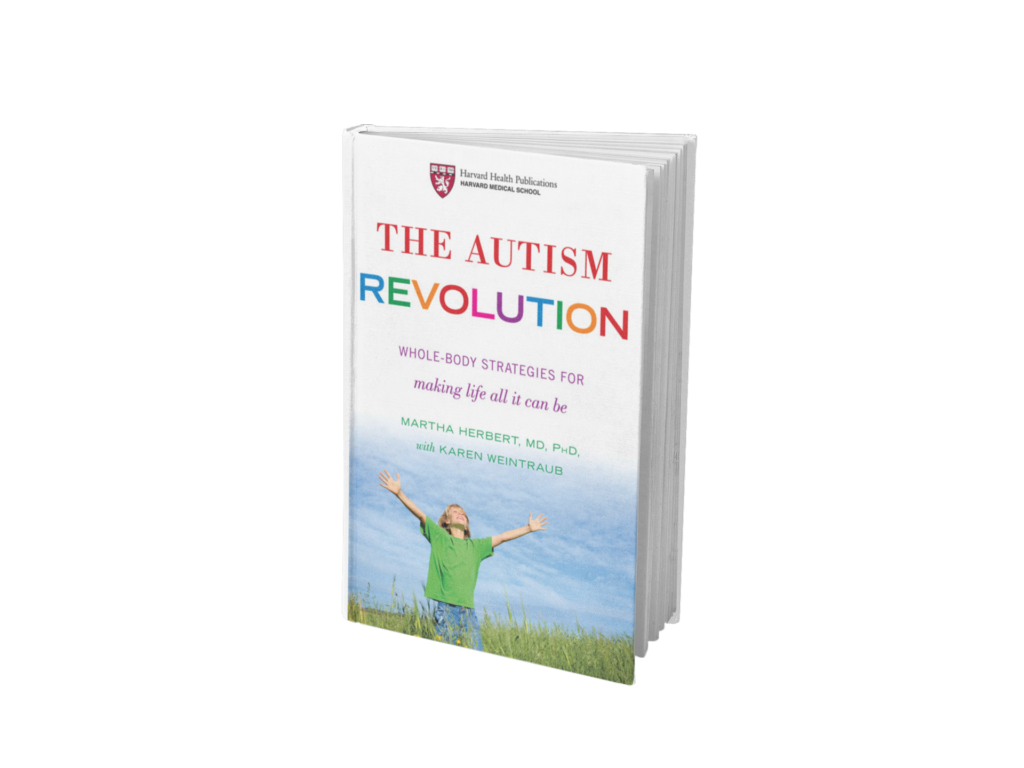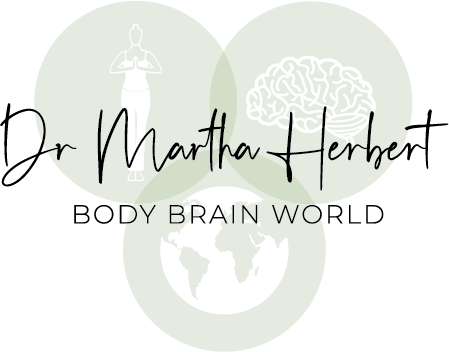 Available in hardcover, paperback, kindle and audio versions
Available in hardcover, paperback, kindle and audio versions
THE AUTISM REVOLUTION: Whole Body Strategies For Making Life All It Can Be. By Martha R. Herbert with Karen Weintraub. Ballantine/Harvard Health Publications, publication date March 27, 2012.
Papers are listed below by type, most with links to full text.
SCIENTIFIC REVIEW PAPERS
1. Herbert MR. Autism: A Brain disorder or a disorder that affects the brain? Clinical Neuropsychiatry 2005; 2(6):354-79.
6. Herbert MR. Autism. chapter in: Gilman S. Neurobiology of Disease (textbook). Elsevier, 2006.
7. Herbert MR, Caviness V. Neuroanatomy and Imaging Studies. in: Tuchman R, Rapin I eds. Autism: A neurobiological disorder of early brain development. Mac Keith Press, 2006: Chapter 8 pp. 115-140.
8. Anderson MP, Hooker BS, Herbert MR. Bridging from Cells to Cognition in Autism Pathophysiology: Biological Pathways to Defective Brain Function and Plasticity. Am J Biochem Biotech 2008; 4(2):167-176 . http://www.scipub.org/fulltext/ajbb/ajbb42167-176.pdf. Published as part of online issue on autism, http://www.scipub.org/scipub/detail_issue.php?V_No=173&j_id=ajbb.
9. Herbert, M.R., Anderson, M.P An Expanding Spectrum of Autism Models: From Fixed Developmental Defects to Reversible Functional Impairments Humana Press 2008 Autism: Current Theories and Evidence, pp. 429-463
10. Helt M, Kelley E, Kinsbourne M, Pandy J, Boorstein H, Herbert MR, Fein D. Can children with autism recover? If so, how? Neuropsychol Rev. 2008 Dec; 18(4): 339-66.
11. Herbert, M.R. Autism: The centrality of active pathophysiology and the shift from static to chronic dynamic encephalopathy Taylor & Francis / CRC Press 2009 Autism: Oxidative stress, inflammation and immune abnormalities, pp. 343-387
12. Herbert M.R. Contributions of the environment and environmentally vulnerable physiology to autism spectrum disorders 2010 20087183 Curr Opin Neurol 103-10. PMID: http://www.ncbi.nlm.nih.gov/pubmed/20087183
13. Herbert, M.R. Environment and vulnerable physiology in autism. Supplement to European Neuropsychopharmacology (ENP), S.09.02, p. S177.
14. Herbert, M.R., Neuroanatomy in Autism. The Neuropsychology of Autism. Fein, D., ed. Oxford University Press (2011).
15. Herbert, M.R., A Whole Body Systems Approach to Autism. The Neuropsychology of Autism. Fein, D., ed. Oxford University Press (2011).
16. Corrales, M., Herbert M.R., Autism and Environmental Genomics: Synergistic systems approaches to autism complexity. Invited. Autism Spectrum Disorders (textbook). Amaral D, Dawson G, Geschwind D, editors. Oxford University Press (2011).
17. Herbert, M.R., SHANK3, the Synapse, and Autism. New England Journal of Medicine (Clinical Implications of Basic Research), 365:2. July 14, 2011, pp. 173-175.
18. Herbert, M.R., Autism: From Static Genetic Brain Defect to Dynamic Gene-Environment-Modulated Pathophysiology. Chapter 10 of Genetic Explanations: Sense and Nonsense. Krimsky, S. and Gruber, J. eds, Harvard University Press (2012). Full chapter with summary & book flyer
19. Herbert, M.R., Buckley, J.A. Autism and Dietary Therapy: Case Report and Review of the Literature. Journal of Child Neurology. 2013, Abstract at Sage Online First. Abstract on Pubmed.
20. Herbert, M.R. and Sage, C. “Autism and EMF? Plausibility of a Pathophysiological Link”. Part 1: Pathophysiology , 2013, Jun;20(3):191-209, epub Oct 4, PMID 24095003. Pubmed abstract for Part 1. Part II: Pathophysiology, 2013 Jun;20(3):211-34. Epub 2013 Oct 8, PMID 24113318. Pubmed abstract for Part II. Also, EMF reference resource: Searchable EMF references on Refworks Connections in our Environment: Sizing up Electromagnetic Fields by M.R. Herbert reviews key points in two pages; published in Autism Notebook Spring 2015, pp.. 24-25. Brief summary version of longer Autism-EMF-pathophysiology papers is also available.
21. Herbert, M.R. Translational Implications of a Whole-Body Approach to Brain Health in Autism: How Transduction between Metabolism and Electrophysiology Points to Mechanisms for Neuroplasticity. Chapter 21 in Valerie Hu, Frontiers in Autism Research: New Horizons for Diagnosis and Treatment. 2014: World Scientific.
22. Goldman A. et al., 2015, Bioregulatory systems medicine: an innovative approach to integrating the science of molecular networks, inflammation, and systems biology with the patient’s autoregulatory capacity? Front. Physiol., 19 August 2015 | http://dx.doi.org/10.3389/fphys.2015.00225 Open Access
5. Herbert MR, Harris GJ, Adrien KT et al. Abnormal asymmetry in language association cortex in autism. Ann Neurol 2002; 52(5):588-96.
6. Granpeesheh, D., Tarbox,J., Dixon, D.R., Carr, E., and Herbert, M.R. Retrospective analysis of clinical records in 38 cases of recovery from autism 2009 19917210 Ann Clin Psychiatry 195-204 PMID: http://www.ncbi.nlm.nih.gov/pubmed/19917210
7. Isler, J.R., Martien, K.M., Grieve, P.G., Stark, R.I., Herbert, M.R. Reduced functional connectivity in visual evoked potentials in children with autism spectrum disorder. Clin Neurophysiol. Epub 2010 June PMID: 20605520
8. Goldman S., O’Brien, L.M., Filipek P.A., Rapin, I., Herbert, M.R. . Research in Autism Spectrum Disorders. Motor stereotypies and volumetric brain alterations in children with Autistic Disorder. 2013; 7:82-92. Free in Pubmed Central.
9. Khan S, Gramfort A, Shetty NR, Kitzbichler MG, Ganesan S, Moran JM, Lee SM, Gabrieli JD, Tager-Flusberg HB, Joseph RM, Herbert MR, Hämäläinen MS, Kenet T. Local and long-range functional connectivity is reduced in concert in autism spectrum disorders. Proc Natl Acad Sci U S A. 2013 Feb 19; 110(8):3107-12 View in: PubMed Free full text at PNAS.
10. Pathway Network Analyses for Autism Reveal Multisystem Involvement, Major Overlaps with Other Diseases and Convergence upon MAPK and Calcium Signaling, by Ya Wen, MJ Alshikho and Martha R Herbert, PLOS ONE 7 April 2016. DOI. Abstract at PMID: 27055244 Download pdf or Open Access at PLOS ONE. Mass General Hospital Press release for paper.
11. Nelson J., Reiserer RS, Lambert L, Marango S., Herbert MR. Modeling Cumulative Environmental Stressors Using a Consilience Approach Supports a Total Load Model of Chronic Childhood Health Conditions. Institute for Functional Medicine AIC 2020 Poster session.
12. Reiserer RS, Lambert B, Nelson J, Herbert, MR., Empirical Analysis and Optimization of Indexed Data for STudies of Synergistic Actions Among Multiple Stressors on Health Outcomes and Resilienc in Children. Institute for Functional Medicine AIC 2021 Poster Session.
13. Reiserer R, Nelson J, Lambert B, Tallman-Ruhm, H, Herbert M., Exploring the Impact of Antibiotic Use on General Health Status in Children by Aggregating Across Machine Learning Models. . nstitute for Functional Medicine AIC 2023 Poster Session.
SCIENTIFIC REVIEWS AND COMMENTARY FOR THE PUBLIC
‘Ecofeminist Science and the Physiology of the Living Body’ in Somatics, Autumn-Winter, 1990.
‘Autism, Health, and the Environment,’ San Francisco Medicine. Nov/Dec 2005
‘Time To Get a Grip,’ Autism Advocate. Lead article in special issue on Autism and Environment. January 2007 also available in French
‘Learning from the autism catastrophe: Key leverage points.’ Guest editorial, Alternative Therapies in Health and Medicine, Nov/Dec 2008, vol 14, no 6., pp. 28-30
‘Integrating Behavioral and Biomedical Approaches: A marriage made in heaven’ by Edward G. Carr, Ph.D.l and Martha R. Herbert, M.D., Ph.D., Autism Advocate, First edition, 2008
“Treatment-Guided Research: Helping people now with humility, respect and boldness.” Autism Advocate 50(1): 8-14
Defying Determinism with Healthy Living, by Martha Herbert. Genewatch 2013 Special Issue on Genetic Education. Council for Responsible Genetics.
Everyday Epigenetics: From Molecular Intervention to Public Health and Lifestyle Medicine. N A J Med Sci. 2013;6(3).
Autism: How it Works and How to Help Better. Metrodocs, Magazine of the Minnesota Twin Cities Medical Society, Sept-Oct, 2013.
Autism Challenges Us to ‘Think Different‘. The Orange County Register, 18 October 2013, Op-Ed Insert.
Connections in our Environment: Sizing up Electromagnetic Fields by M.R. Herbert (published in Autism Notebook Spring 2015, pp.. 24-25) reviews in two pageskey points of the more technical Herbert & Sage Autism-EMF paper above, #22.
NEWS COVERAGE and PRINTED INTERVIEWS
Letter to Editor of New York Times on Narrowing the Definition of Autism, January 27, 2012.
Autism: A brain disorder or a disorder that affects the brain? Teri Arranga interviews Martha Herbert. Medical Veritas 3 (2006) 1182–1194
‘Autism-It’s Not Just In the Head,’ by Jill Neimark, Discover Magazine, April 2007
TRANSCENDing the Gaps in Autism Research, Interview by Frank Lampe and Suzanne Snyder, Alternative Therapies in Health and Medicine, Nov/Dec 2007, Vol 13, No. 6
BLOGS
AUTISM BRAIN ORIGINS-ENVIRONMENT AND PHYSIOLOGY REALLY MATTER. Blog by Martha Herbert, July, 2014. Critique of Stoner/Courchesne “Patches” paper in New England Journal of Medicine. A summary version of this blog was posted by Autism Speaks on July 28, 2014 at http://www.autismspeaks.org/blog/2014/07/28/more-prenatal-genetics-search-autism%E2%80%99s-origins
WHY AREN’T WE THERE YET? Valuable but incomplete measures of brain changes in babies with autism
DEFYING DETERMINISM WITH HEALTHY LIVING. Genewatch 2013 special issue on Genetic Education.
HOUSEKEEPING AND HIGHER FUNCTIONS ARE MARRIED AND INSEPARABLE IN THE BRAIN
Risk vs Cause: What’s the difference between something causing autism versus increasing risk for autism? A version was published on the Autism Speaks blog: https://www.autismspeaks.org/blog/2012/04/18/risk-vs-cause-autism
Obesity, Diabetes, and Autism Risk: Much That You Can Do
BIGGER THAN AUTISM, BIGGER THAN GENES: A WHOLE-BODY APPROACH TO MUTATIONS, AND WHAT YOU CAN DO
